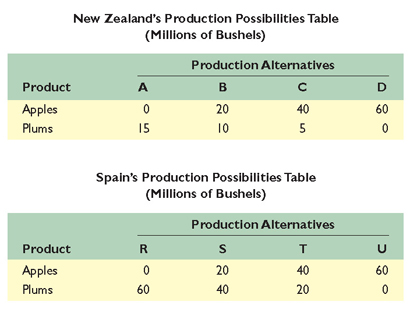
Economics (McConnell), 18th EditionChapter 37: International TradeKey Questions1. Below are hypothetical production possibilities tables for New Zealand and Spain. Each country can produce apples and plums. a. What is each country's cost ratio of producing plums and apples.  c. Show the trading possibilities lines for each nation if the actual terms of trade are 1 plum for 2 apples. (Plot these lines on your graph.) 2. Refer to Figure 3.6, page 55. Assume that the graph depicts the U.S. domestic market for corn. How many bushels of corn, if any, will the United States export or import at a world price of $1, $2, $3, $4, and $5? Use this information to construct the U.S. export supply curve and import demand curve for corn. Suppose the only other corn-producing nation is France, where the domestic price is $4. Which country will export corn; which will import it? 3. Draw a domestic supply and demand diagram for a product in which the United States does not have a comparative advantage. What impact do foreign imports have on domestic price and quantity? On your diagram show a protective tariff that eliminates approximately one-half the assumed imports. What are the price-quantity effects of this tariff on (a) domestic consumers, (b) domestic producers, and (c) foreign exporters? How would the effects of a quota that creates the same amount of imports differ? |  |















